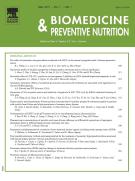Gossypin, a flavonol glucoside protects pancreatic beta-cells from glucotoxicity in streptozotocin-induced experimental diabetes in rats - 09/11/12

Abstract |
Chronic oxidative stress caused by glucotoxicity plays a crucial role in the onset and progression of pancreatic beta-cell dysfunction in diabetes mellitus. Several studies have reported that flavonoids protect tissues from oxidative damage by its antioxidative potential. The present study was aimed to investigate the antioxidant activity of gossypin by DPPH and ABTS radical scavenging assays and its role on glucotoxicity mediated pancreatic beta-cell dysfunction in streptozotocin-induced experimental diabetes in rats. Gossypin effectively scavenges both 2,2-Diphenyl-1-picrylhydrazyl (DPPH) and ABTS radicals generated in the reaction mixtures, which implies the antioxidant property of gossypin. Oral administration of gossypin to diabetic rats significantly improved the antioxidants and reduced the levels of lipid peroxides, nitric oxide, IL-1β and nuclear NF-κB p65 unit in pancreatic tissues. The improved insulin content in pancreas and plasma in the experimental diabetic rats treated with gossypin as well as histological observations demonstrate the possible role of gossypin in the protection of pancreatic beta-cells. In addition, blood glucose, HbA1c, glutathione, lipid peroxides, IL-1β levels in plasma and nitric oxide level were significantly altered upon treatment with gossypin. It is concluded that the pancreatic islet beta-cell protective role of gossypin against glucotoxicity mediated oxidative damage might be attributed by its antioxidative potential.
Le texte complet de cet article est disponible en PDF.Keywords : Gossypin, Flavonoid, Streptozotocin, Pancreatic beta-cells, Glucotoxicity
Plan
Vol 2 - N° 4
P. 239-245 - octobre 2012 Retour au numéroBienvenue sur EM-consulte, la référence des professionnels de santé.
L’accès au texte intégral de cet article nécessite un abonnement.
Déjà abonné à cette revue ?

